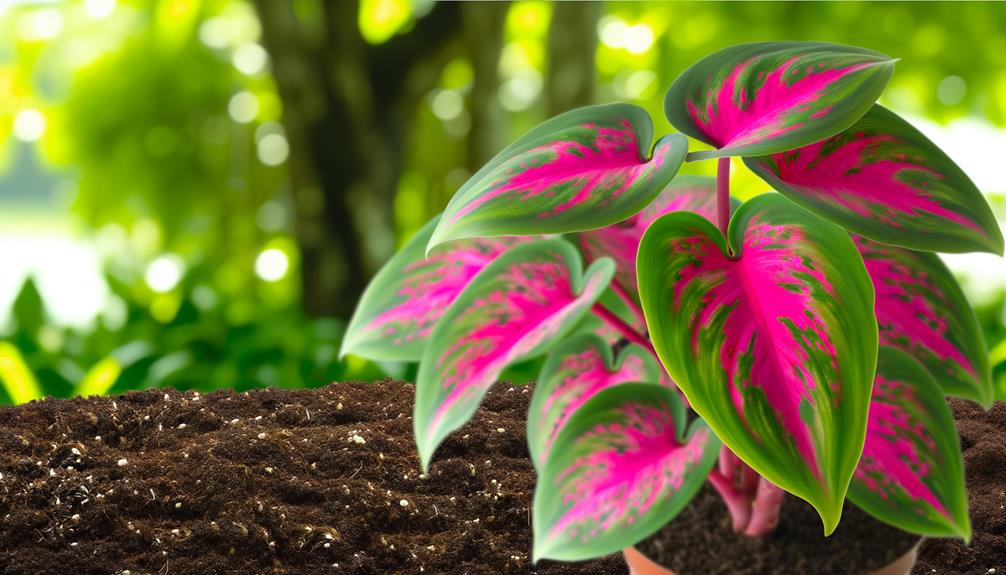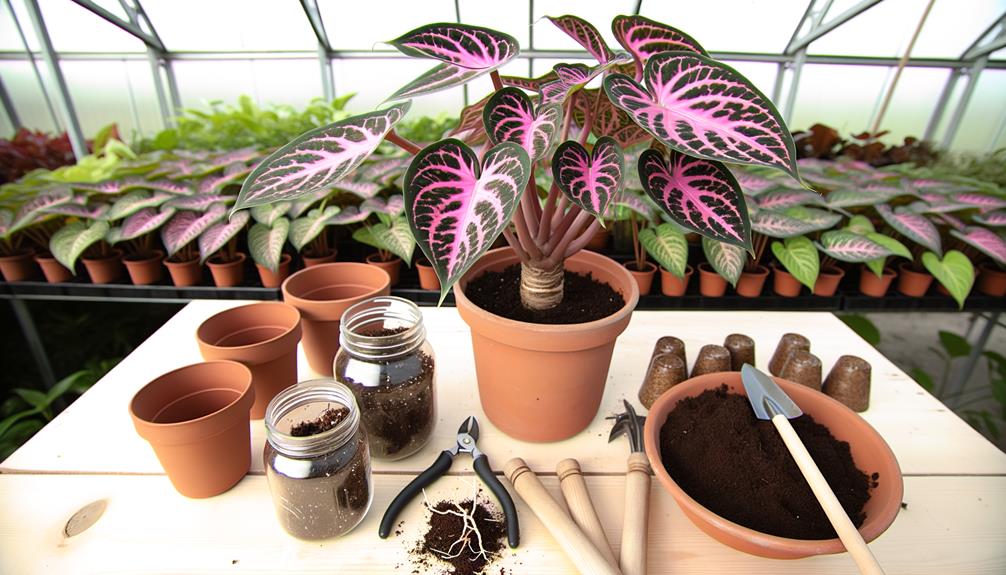What Is a Highly Variegated Pink Princess Philodendron?
A highly variegated Pink Princess Philodendron (Philodendron erubescens) exhibits distinct, mosaic leaf patterns due to genetic mutations affecting chlorophyll distribution. These mutations impact chloroplast expression, producing distinctive pink and green patches.
The plant thrives under bright, indirect light, requiring well-draining, nutrient-rich soil and consistent moisture levels to prevent root rot. Regular pruning helps maintain its structural integrity and variegation.
Its vining growth habit and ability to propagate through stem cuttings make it a fascinating specimen for botanical enthusiasts. To uncover the nuances of its care and propagation methods, further exploration is warranted.

Key Takeaways
- A highly variegated Pink Princess Philodendron features significant pink and green patches due to genetic mutations affecting chlorophyll distribution.
- Variegation results in distinct, striking patterns of pink and green on leaves, enhancing the plant's aesthetic appeal.
- Bright, indirect light is crucial for maintaining and enhancing the variegation in the leaves.
- Proper watering and well-draining soil are essential to prevent root rot and support healthy growth.
- Regular pruning and propagation through stem cuttings help maintain variegation and structural integrity.
Understanding Variegation

Variegation in plants, characterized by the presence of differently colored zones on the leaves, stems, or other parts, results from genetic mutations or chimerism that affect chlorophyll distribution. This phenomenon can manifest as distinct patches, streaks, or marbling of colors, typically involving green alongside white, yellow, or even pink.
In the Pink Princess Philodendron, variegation is particularly valued for its striking pink hues interspersed with deep green. The variegation arises due to the differential expression of chloroplasts, which are the cellular sites of photosynthesis. Areas lacking chlorophyll exhibit non-green colors due to accessory pigments or the absence of pigmentation.
Understanding the mechanisms behind variegation is essential for cultivation and propagation, ensuring the aesthetic traits are maintained and enhanced.
Genetic Factors
The variegation observed in the Pink Princess Philodendron primarily results from genetic mutations affecting chlorophyll distribution within the plant cells.
These mutations are typically somatic and can be inherited in a chimeral pattern, leading to distinct sectors of green and pink tissue.
Understanding the specific genetic mechanisms and inheritance patterns is essential for horticulturists aiming to propagate highly variegated specimens consistently.
Variegation Genetic Basis
Understanding the genetic basis of variegation in the Pink Princess Philodendron involves dissecting the intricate interplay of nuclear and chloroplast genes that govern pigment distribution.
Variegation, characterized by the presence of both green and pink tissues, results from disruptions in chlorophyll production. Key nuclear genes regulate chloroplast function and pigment synthesis pathways, while mutations in these genes can lead to non-green pigmentation.
Chloroplast genes also play a pivotal role, as they directly affect the plant's photosynthetic machinery. This genetic complexity leads to mosaic patterns, where cells exhibit differential gene expression.
Consequently, the phenotype's stability is influenced by both genetic consistency and environmental factors, making the Pink Princess Philodendron's variegation a fascinating subject of botanical genetics.
Mutation Inheritance Patterns
Mutations influencing variegation in the Pink Princess Philodendron are inherited through complex genetic mechanisms involving both Mendelian and non-Mendelian patterns. Mendelian inheritance suggests a dominant or recessive allele dictating variegation, but non-Mendelian factors, such as incomplete dominance, codominance, and epigenetic modifications, also play pivotal roles.
Chloroplasts, containing their own genetic material, contribute to this variegation through cytoplasmic inheritance, inherited maternally. Additionally, transposable elements and somatic mutations can induce variegation within individual plants. The intricate interplay of these factors results in the striking pink and green patterns characteristic of highly variegated specimens.
Understanding these genetic intricacies is essential for breeders aiming to enhance the aesthetic appeal and stability of variegated traits in the Pink Princess Philodendron.
Leaf Coloration

Leaf coloration in the highly diversified Pink Princess Philodendron arises from a complex interplay of genetic factors and chlorophyll distribution.
The distinct pink and green mosaic patterns result from a mutation in the plant's DNA affecting chloroplast development. Chlorophyll, essential for photosynthesis, is unevenly distributed, leading to areas of reduced pigment where the pink coloration manifests.
This diversification is not merely aesthetic; it also impacts the plant's photosynthetic efficiency. The degree of diversification can vary considerably between individual leaves, influenced by genetic expression and environmental factors such as light intensity.
Ideal light conditions can enhance the pink pigmentation by promoting the expression of anthocyanins, compounds responsible for the red to purple hues observed in the diversified portions.
Growth Patterns
The unique leaf coloration of the Pink Princess Philodendron is closely tied to its growth patterns, which exhibit a vining habit characterized by elongated stems and aerial roots. This species demonstrates indeterminate growth, allowing it to spread extensively if provided with suitable support structures.
The plant's growth pattern can be summarized as follows:
- Stem Elongation: Stems can reach lengths of several meters, necessitating regular pruning for indoor cultivation.
- Aerial Root Development: These roots aid in climbing and nutrient absorption, enhancing the plant's vigor.
- Node Formation: Nodes appear along the stem, from which leaves and aerial roots emerge.
- Internodal Spacing: Variegation affects internodal length; higher variegation typically results in shorter internodes.
Understanding these growth patterns is essential for effective management and aesthetic maximization.
Light Requirements

The Pink Princess Philodendron thrives under bright, indirect light, which optimizes its variegation. Exposure to direct sunlight can cause leaf scorch and pigment degradation, thereby diminishing its aesthetic appeal.
Artificial lighting, particularly full-spectrum LED lights, can effectively supplement natural light, promoting robust growth in indoor environments.
Ideal Light Conditions
Achieving best variegation and growth in a Pink Princess Philodendron necessitates exposure to bright, indirect light to prevent leaf burn and maintain vibrant coloration. Ensuring optimal light conditions involves understanding the plant's photoreceptive needs.
Here are key considerations:
- Light Intensity: Provide 10,000 to 20,000 lux, mimicking dappled sunlight.
- Duration: Aim for 12-14 hours of light per day, ideally using supplemental grow lights during shorter winter days.
- Light Source: Position near east or west-facing windows where filtered light prevails.
- Light Uniformity: Rotate the plant weekly to guarantee even light distribution, preventing asymmetrical growth.
Proper light management is essential for sustaining the plant's distinct variegation and overall health.
Avoid Direct Sunlight
Direct sunlight exposure can result in photodamage, leading to leaf scorch and diminished variegation in Pink Princess Philodendron.
This horticultural phenomenon occurs because intense solar radiation disrupts chlorophyll and anthocyanin pigments, essential for the plant's characteristic coloration.
Ideal light conditions for this species involve bright, indirect sunlight, which mimics the dappled light found in its native tropical understory habitat.
Ensuring proper light filtration, such as using sheer curtains or positioning the plant in east-facing windows, can mitigate the risks of photoinhibition and photobleaching.
Additionally, maintaining a consistent light environment aids in preventing etiolation, wherein the plant exhibits elongated growth and reduced foliage density due to inadequate light.
Adhering to these guidelines promotes robust growth and vibrant variegation.
Growth With Artificial Light
Utilizing artificial light sources can effectively replicate the ideal conditions required for the healthy development and vibrant variegation of Pink Princess Philodendron.
To enhance artificial lighting, consider the following guidelines:
- Light Intensity: Use LED grow lights with a spectrum of 400-700 nm to simulate natural sunlight, maintaining a level of 200-400 micromoles per square meter per second.
- Duration: Keep a photoperiod of 12-16 hours per day to mirror the long daylight hours of the plant's native tropical environment.
- Positioning: Place the light source 12-24 inches above the plant to prevent excessive heat and light stress.
- Light Quality: Utilize full-spectrum grow lights to provide a balanced ratio of blue and red wavelengths, essential for photosynthesis and variegation maintenance.
These parameters guarantee optimal development and aesthetic appeal.
Watering Needs
Proper watering of the highly variegated Pink Princess Philodendron is essential, as both overwatering and underwatering can lead to root rot or desiccation, respectively. Best hydration involves maintaining consistent soil moisture without saturation. It is advisable to allow the top 1-2 inches of soil to dry out between waterings. This practice reduces the risk of pathogenic fungal growth and root damage.
Employing a well-draining potting mix and ensuring adequate drainage holes in the container can further mitigate overwatering risks. During the growing season, increased watering frequency may be necessary, while in the dormant winter months, watering should be reduced.
Monitoring environmental humidity levels, ideally between 60-80%, can also support healthy hydration and overall plant vigor.
Soil Preferences

The Pink Princess Philodendron requires a well-draining, nutrient-rich soil composition to promote excellent growth.
Ensuring proper aeration and drainage is crucial to prevent root rot and facilitate healthy root development.
Maintaining consistent soil moisture levels, while avoiding waterlogging, is essential for the plant's health and variegation stability.
Ideal Soil Composition
For ideal growth, a highly variegated Pink Princess Philodendron requires a soil composition that is well-draining, rich in organic matter, and slightly acidic with a pH range of 5.5 to 6.5.
The following soil components are recommended to achieve these conditions:
- Peat Moss: Retains moisture while providing necessary acidity.
- Perlite: Enhances drainage and aeration to prevent root rot.
- Compost: Supplies essential nutrients, boosting organic matter content.
- Bark Chips: Improves soil structure and longevity, aiding in moisture retention.
These elements combined create an optimal environment, promoting robust root development and vibrant foliage.
Drainage and Aeration
Achieving ideal growth conditions for a highly variegated Pink Princess Philodendron necessitates not only the right soil composition but also careful attention to drainage and aeration. Best drainage is essential to prevent waterlogged conditions, which can lead to root rot and other fungal infections.
Using a well-draining substrate such as a mix of perlite, orchid bark, and peat moss ensures that excess water can efficiently exit the root zone. Simultaneously, adequate aeration is vital for root respiration and nutrient uptake. Including components like coarse sand or coconut coir can improve soil aeration, facilitating oxygen flow to the roots.
Such detailed attention to both drainage and aeration creates an environment conducive to the robust growth and variegation of the Pink Princess Philodendron.
Soil Moisture Levels
How important are ideal soil moisture levels in enhancing the health and striking variegation of the highly variegated Pink Princess Philodendron? Maintaining optimal moisture is essential to prevent root rot and promote vibrant foliage.
The Pink Princess Philodendron thrives in consistently moist but not waterlogged soil. Here are four essential guidelines:
- Watering Frequency: Water when the top 1-2 inches of soil feel dry to the touch.
- Soil Composition: Utilize a well-draining mix containing peat, perlite, and orchid bark.
- Humidity Levels: Maintain ambient humidity around 60-70% to prevent leaf desiccation.
- Water Quality: Use distilled or rainwater to avoid chlorine and fluoride accumulation.
Adhering to these practices ensures the plant's health and enriches its variegation.
Fertilization Tips
Proper fertilization of the Pink Princess Philodendron involves the application of a balanced, water-soluble fertilizer with an N-P-K ratio of 10-10-10, administered bi-monthly during the growing season. This guarantees the plant receives essential macronutrients—nitrogen for foliage growth, phosphorus for root development, and potassium for overall plant health.
Fertilizer should be diluted to half the recommended strength to prevent nutrient burn, a common issue in container plants. Additionally, it is vital to apply the fertilizer when the soil is already moist, thereby reducing the risk of root damage.
Avoid fertilizing during the dormancy period, typically in the winter months, as this can lead to nutrient accumulation and subsequent toxicity.
Pruning Techniques

Effective pruning of the Pink Princess Philodendron is crucial for maintaining its structural integrity and promoting optimal variegation. Expertly executed pruning practices not only enhance aesthetic appeal but also stimulate vigorous growth.
To optimize pruning, consider the following guidelines:
- Sterilize Tools: Always use sterilized pruning shears to prevent pathogen transmission.
- Selectively Trim: Focus on removing leggy, non-variegated, or diseased stems to promote variegation.
- Timing: Prune during the growing season (spring and summer) to facilitate rapid recovery and regrowth.
- Angle Cuts: Make cuts at a 45-degree angle to minimize water retention and reduce the risk of rot.
Following these techniques guarantees the Pink Princess Philodendron remains healthy and visually appealing.
Common Issues
Despite careful pruning practices, the Pink Princess Philodendron may still face several common issues that can impact its health and appearance.
Chlorosis, often resulting from nutrient imbalances, shows as yellowing leaves and can be reduced by ensuring appropriate fertilization.
Pest infestations, especially spider mites and aphids, present significant threats and require regular inspection and treatment with insecticidal soap or neem oil.
Additionally, root rot, usually caused by overwatering, is a crucial concern and can be prevented by maintaining well-draining soil and proper watering schedules.
Lastly, insufficient light conditions can lead to etiolation, characterized by elongated, weak stems. Providing bright, indirect light is vital to support robust growth and maintain variegation.
Addressing these issues promptly guarantees optimal plant health.
Propagation Methods

Propagation of the Pink Princess Philodendron is typically achieved through stem cuttings. This method guarantees genetic consistency and high success rates.
To maximize propagation success, follow these precise steps:
- Selection of Cutting: Choose a healthy stem with at least one node and a leaf. Confirm the presence of variegation for ideal aesthetic results.
- Cutting Technique: Use a sterilized, sharp blade to make a clean cut below the node. This helps prevent infection and supports root development.
- Rooting Medium: Place the cutting in water or a well-draining potting mix. Maintain consistent moisture levels.
- Environmental Conditions: Provide indirect sunlight, high humidity, and temperatures between 70-80°F (21-27°C). These conditions promote root growth.
These steps ensure strong propagation and preservation of variegation.
Conclusion
To sum up, the highly diverse Pink Princess Philodendron exemplifies the intricate interplay of genetic factors and environmental conditions that influence variegation.
Understanding the plant's needs, from specific light requirements to appropriate fertilization and pruning techniques, is essential for best growth.
As the saying goes, 'knowledge is power,' and mastery over propagation methods and common issues guarantees the thriving of this unique botanical specimen.
Therefore, thorough care leads to the flourishing of this distinct and aesthetically pleasing philodendron variety.






